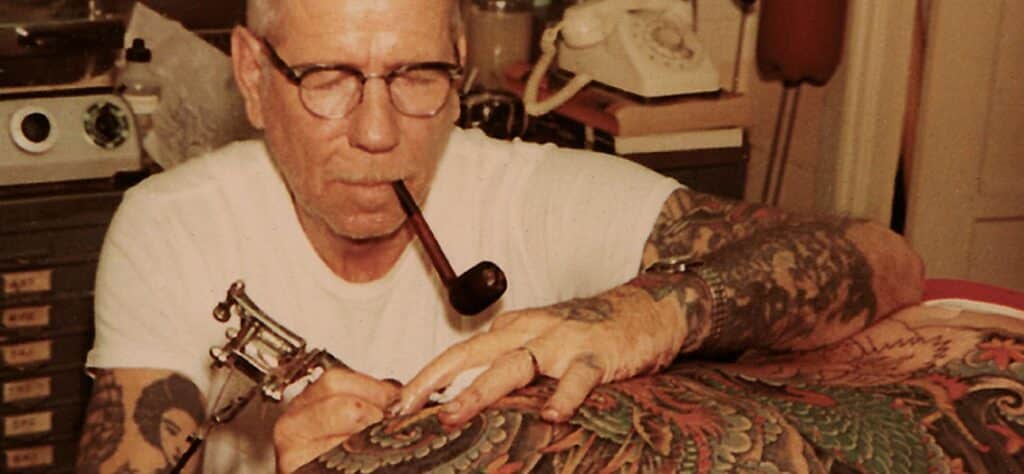Anyone who wants to get into the tattooing world should know their tattooing history. When it comes to American Tattoo folklore, one name rises above all the rest.
Sailor Jerry is American Tattooing royalty who paved the way for many of the modern techniques and styles you’re familiar with today.
His influence extended even beyond the art form, cementing his legacy as one of the forefathers of modern tattooing.
But who exactly was Sailor Jerry Collins really, and how did his legacy continue to impact the tattooing world till this day? Let’s find out.
Early Life Sailor Jerry
Born on January 14th, 1911, in Reno, Nevada, Normal Keith Collins had a colorful childhood and teenage years that helped shape his tattooing career.
From a young age, Collins displayed a strong interest in art and tattooing.
During his teenage years, he would hop freight trains across the United States, exposing him to various cultures and the burgeoning tattoo scene within the country.
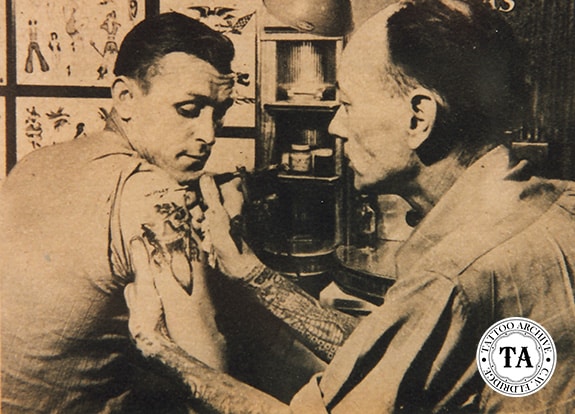
Photo credit: The Tattoo Archive
During his travels, Collins learned tattooing from prominent tattoo artists at the time, such as "Big Mike" from Alaska, who taught him how to use hand tools to tattoo.
He also spent some time in Chicago, where he worked with Gib "Tatts" Thomas and honed his skills even further.
During the 1930s, Collins enlisted in the U.S. Navy, which was a pivotal experience for his tattooing career as it exposed him to the rich traditions of Southeast Asian and Polynesian tattooing.
These travels deeply influenced his tattoo style, which later became synonymous with bold, nautical themes, such as ships, anchors, and eagles.
These experiences not only shaped his tattooing style but also his moniker, as he became famously known as "Sailor Jerry."
Sailor Jerry’s Time In The Navy
While in the Navy, Sailor Jerry was stationed in locations such as China and Japan. Here, he began to absorb the local art and tattooing traditions.
Thanks to this exposure, he blended different styles into his work, incorporating elements such as Asian dragons, Hawaiian themes, and traditional American designs, all of which contributed to a distinctive and influential aesthetic.
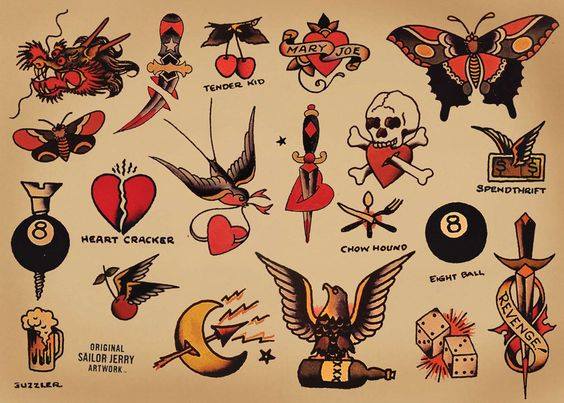
Photo credit: BRAVEST KIDS TATTOO
During his service, he also honed his skills in traditional American tattooing.
His experiences at sea led him to encounter sailors from around the world with various tattoos.
This fed his fascination and respect for the art form, leading him to push for higher standards in tattoo hygiene and quality.
After leaving the Navy, Sailor Jerry settled in Hawaii as it was a strategic location that allowed him to tattoo sailors passing through Pearl Harbor during World War II.
This period was crucial, as it allowed him to establish his reputation and continue evolving his techniques and style.
His shop became legendary for sailors who wanted to get inked by a fellow serviceman who had mastered his craft on the global stage.
Sailor Jerry - After The Navy
Sailor Jerry’s legendary Tattoo shop, named ‘Sailor Jerry’s Tattoo Shop’ was located in Honolulu’s Chinatown, where he tapped into a steady stream of sailors and military personnel who were eager to get tattoos to commemorate their travels and experiences.
His shop became a landmark in the area, becoming famous for its high-quality work and rigorous standards of hygiene.
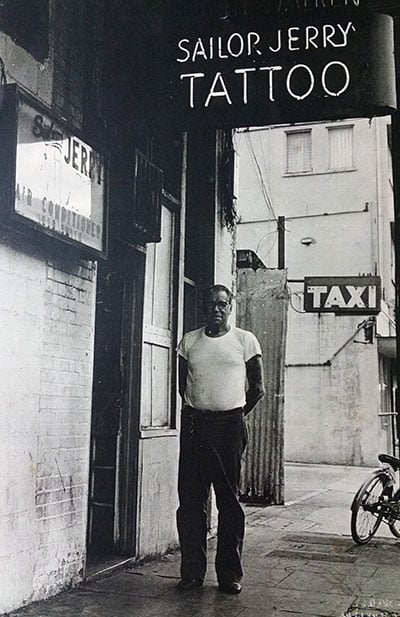
Photo credit: HONOLULU Magazine
Sailor Jerry's tattoos became known for their strong, clean outlines, which is a fundamental characteristic of the American traditional tattoo style.
These bold lines made his designs stand out and remain clear and distinct even as the skin aged.
Sailor Jerry didn’t just settle on being solely a tattoo artist.
He was also an innovator who aimed to push the art form forward, modifying tools and experimenting with pigments to create brighter, more enduring colors.
His commitment to safety also led him to advocate for better sanitary practices, which significantly impacted how tattoo studios operated worldwide.
Sailor Jerry would also mentor numerous younger tattoo artists during his time in Honolulu, including prominent figures like Ed Hardy and Mike Malone, who would go on to become tattoo legends in their own right.
His teachings and philosophy about art and business left a lasting mark on his protégés and helped shape the future of modern tattooing.
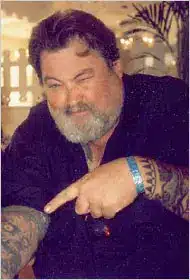
Michael Malone - Photo credit: The New York Times
Apart from tattooing, Sailor Jerry was also deeply engaged with his local community.
He maintained a passion for radio communications by using his skills as a licensed radio operator to connect with people across the globe.
He was known for his sharp wit, profound philosophical insights, and staunch libertarian views, often engaging in lively discussions and debates with friends and customers.
Sailor Jerry’s Death And Continued Legacy
Sailor Jerry passed away in 1973 due to a heart attack, but his influence didn't end there.
His protégés, Hardy and Malone, continued his work and ethos, helping to cement his legacy even further.
His life and work has been celebrated in documentaries, books, and even a commercial brand that includes a popular line of rum and apparel, ensuring that his name remains synonymous with the art of tattooing.
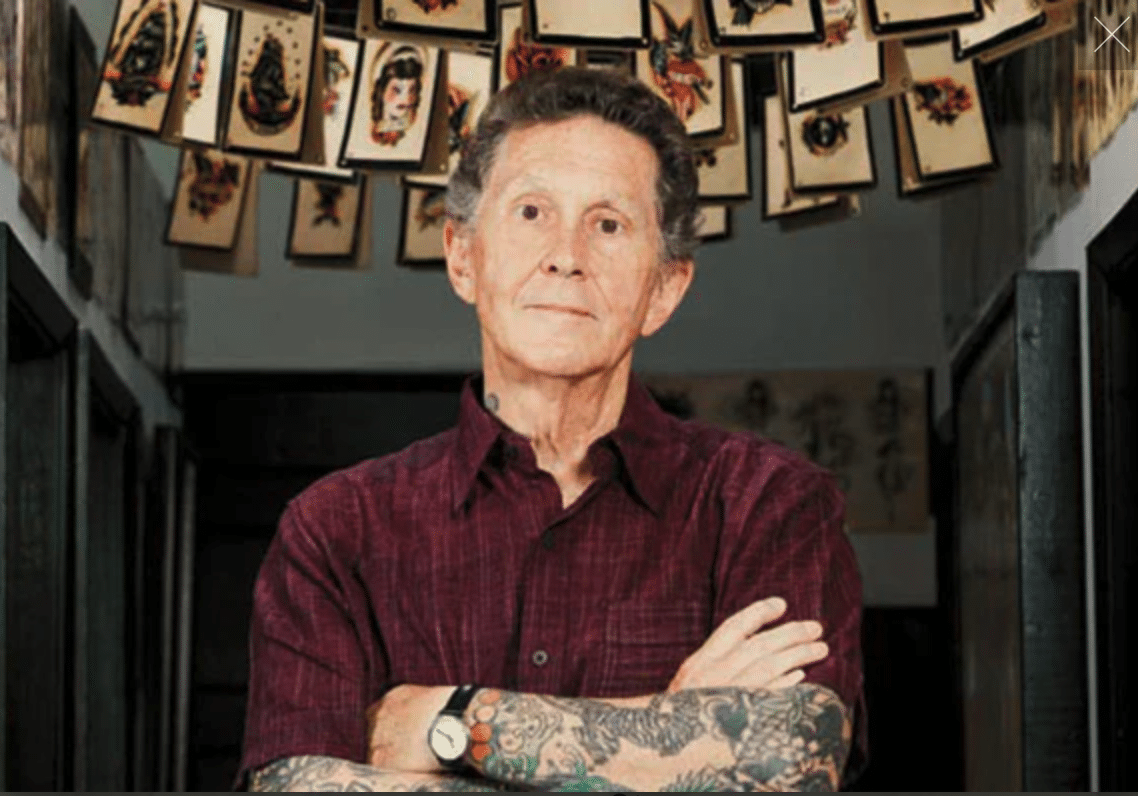
Don Ed Hardy - Photo credit: Ed Hardy's Tattoo City
While Sailor Jerry’s death marked the end of an era in tattooing, his influence and legacy continue to resonate in the tattoo community and culture to this day.
His influence inspired up-and-coming tattoo artists to modernize his Traditional style, developing new styles such as the Neo-Traditional Tattoo, which utilizes his symbolic imagery and style but often adds a modern twist, incorporating additional decorative details or merging them with surreal and modern themes.
While you may not think that the realistic tattoo style is directly connected to Sailor Jerry's traditional work, his emphasis on precision and detail inspired artists across all genres to push the boundaries of what is possible with tattoo ink.
Sailor Jerry's ability to capture the essence of his subjects in a simple yet profound way has encouraged realism artists to pursue excellence in their renderings of life-like images.
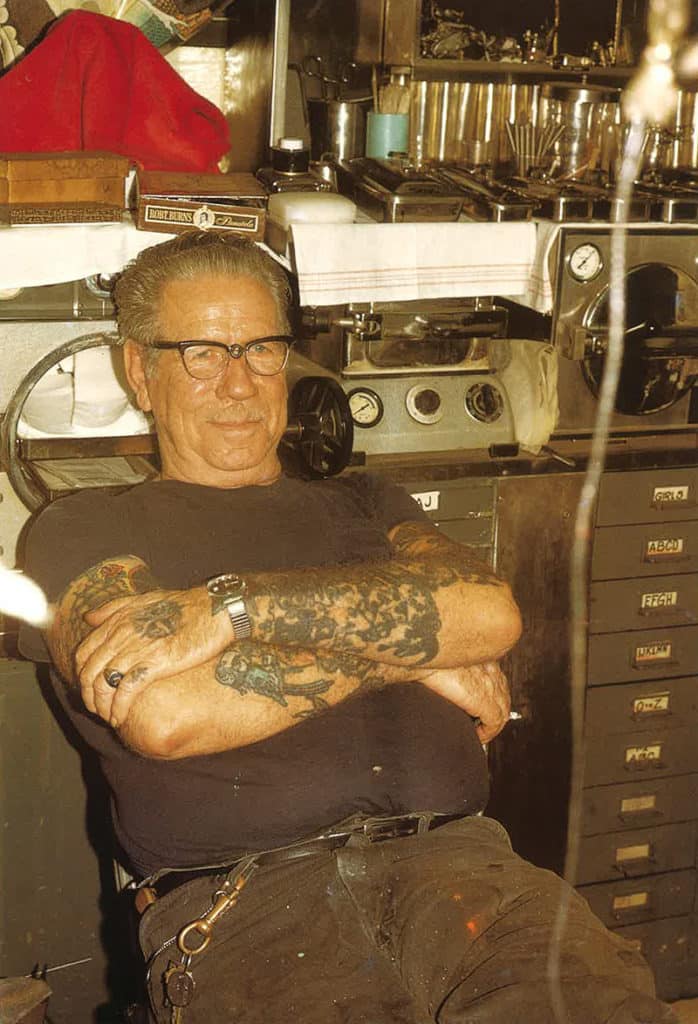
Photo credit: No Land Tattoo Parlour
As Sailor Jerry was significantly influenced by Japanese tattooing, his blending of Japanese elements with American style helped popularize Japanese themes in Western tattooing.
To this day, many modern artists continue to explore this cross-cultural fusion, often citing Sailor Jerry as a pioneer in bringing Japanese aesthetics to a broader audience.
His use of bold lines and high contrast in his designs has gone on to inspire the blackwork style.
This still is where large areas of pure black ink are used to create dramatic patterns and imagery.
Blackwork artists often draw on the strong outlines and distinct shapes that were characteristic of Sailor Jerry’s designs, adapting them into more abstract or geometric forms
While Sailor Jerry didn’t invent the concept of flash sheets, he certainly helped to popularise them by having many of his designs throughout his shop with his iconic designs.
This practice has inspired countless tattoo artists to create their own flash art, often drawing directly from or adapting Sailor Jerry’s iconic designs.
This has kept his influence alive within shop cultures around the world, allowing his style to influence even those who may not directly replicate his tattoos.
Conclusion
Sailor Jerry has left a legacy that transcends time and continues to influence the art of tattooing worldwide.
His pioneering spirit not only set the stage for modern tattoo techniques but also inspired a cultural amalgamation in tattoo styles.
His story is a testament to the enduring power of creativity and innovation in the ever-evolving world of tattoos.
If you’re looking to learn some more tattooing history, you can learn all about how Samuel O’Reilly invented the first ever tattooing machine, how sailors brought tattooing back to the European peninsula, or learn about early tattooing methods.
- Kristen Bell Tattoos - July 15, 2024
- Risks of Tattooing - July 3, 2024
- Early Tattooing Methods - June 22, 2024

